
Lava tubes Within the Zuni-Bandera Lava Flows
The following images were taken as part of the 2000 Rockin' around New Mexico meeting, held in Grants, New Mexico. The captions and locations were prepared by participants on the field trip. For an enlarged version of any image, click on the small version of the image.
Lava tubes are a very interesting feature of basaltic lava flows. As basaltic lava cools, the outer part can solidify to form a shell around the inner, still molten and flowing part. The cool crust acts as a very effective insulator for the inner, hotter lava, allowing it to flow for very great distances, and greatly extends the distances over which basaltic lava flows can travel. Single lava tubes up to 10 km in length have been recognized in Hawaii (Francis, 1993). Lava tubes have been recognized in many parts of the world, and also may have been recognized on giant Martian volcanoes (Francis, 1993). The following photos illustrate a number of features observed in a lava tube called Junction Cave near Grants, NM.
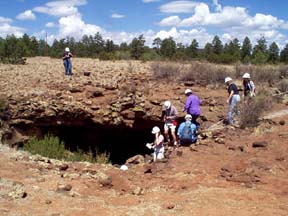 |
GPS LOCATION: SE opening: N34° 58.142'
W108° 00.172' CAPTION: This photo shows the collapsed entrance to a lava tube with people decending. The entrance to the lava tube is probably similar to the collapse pit seen at the pahoehoe stop. The ground surface at the entrance appears to be sandy with occasional large vesicular rock rubble. The pahoehoe flow has been filled in by loess, wind deposition. The tube that extends from the cave opening was formed by lava moving at a moderate rate down a 1:3 to 1:5° slope over an extended time. The tube is dendritic in shape, like a leaf, with small side channels. |
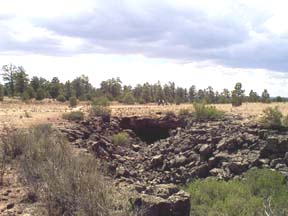 |
GPS LOCATION: NW opening: N34° 58.167'
W108° 00.229' CAPTION: This photo shows the northwest opening of Junction lava tube, looking from the northwest toward the main entry on the southeast (where people are standing). This photo give an idea of the trend of the lava tube. The two entrances are two collapsed portions of the lava tube. Vegetation on the lava is rooted in several inches of reddish sandy windblown dust, suggesting that the flow is older than the McCarties flow. Plants include juniper, piñon pine, ponderosa pine, Apache plume, rubber rabbit brush, Indian paintbrush, prickly pear cactus as well as several grass species. Lava at the surface is considerably weathered showing no volcanic glass on its surface indicating a lava flow old enough for weathering of the surface to have occurred. |
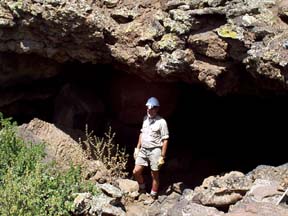 |
GPS LOCATION: SE opening: N34° 55.142'
W108° 00.172' NW opening: N34° 58.167' W108° 00.029' CAPTION: Keith Julian (2m tall) standing in front of large blocks of lava in the Junction Lava tube. When the lava tube emptied, the lava on the ceiling solidified and contracted upon cooling. This contraction form fractures in the lava and large blocks subsequently fell from the ceiling. If another lava flow had occurred through the same tube, the new lava flow would have pushed these blocks along with it, rounding the blocks into lava balls. |
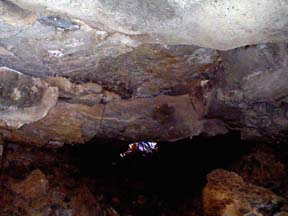 |
GPS: No locations could be taken in cave CAPTION: "Looking Outward Toward Junction Cave Opening from the Inside". The relatively small (2-meter high by 5-meter wide) opening to this dendritic lava tube system is silhouetted against the dark basaltic walls, roof, and floor of the Junction Cave. Note numerous large blocks, which have dropped off the roof and now fill the bottom of the cave interior, which might once have been more than 10 meters high and 15 meters wide. |
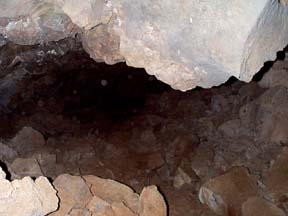 |
GPS: No locations could be taken in cave CAPTION: "Looking Inward into Junction Cave Lava Tube About 100 meters from the Entrance: Junction Cave is actually a complex dendritic lava tube system more than 400 meters long, with several branching sub-tubes (hence the designation "dendritic"). Among the unique features formed naturally in large lava tubes found in the Malpais are: "tube lining," which look like glazed elephant skin; lateral "side benches" formed by multiple flows at different levels; "curl-down" caused by highly plastic cave wall lining breaking loose, with its top sagging inward; and fallen "roof blocks" some of the size of refrigerators, which have become unattached as a result of internal gravitational mass wasting. |
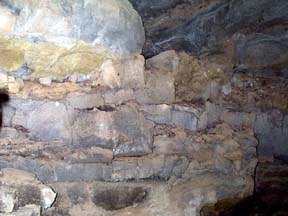 |
GPS: No locations could be taken in cave CAPTION: The side of the lava tube illustrates that pahoehoe lava flows can be made up of many thin flows, rather than a single, thick body. In this photo, it appears that at least 5 thin flows are present, the breaks between flows being demarcated by the presence of the vesicular (bubbly) horizons that form at the top of a lava flow. Pahoehoe flows are not nececessily perfectly flat, but can be lobate. A possible lobate flow tongue can be seen half way up the right-hand side of the photo. To see an active example of a lobate flow, click here. |
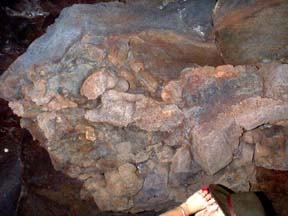 |
GPS: No locations could be taken in cave CAPTION: This photograph also illustrates the presence of multiple pahoehoe flows, but viewed from beneath, rather than from the side. The vesicular top of the underlying flow can be seen as the reddish areas on the photo. The overlying flow is the blacker material. The overlying flow was apparently very fluid when it was emplaced, because it conforms smoothly to the top of the underlying flow. |


